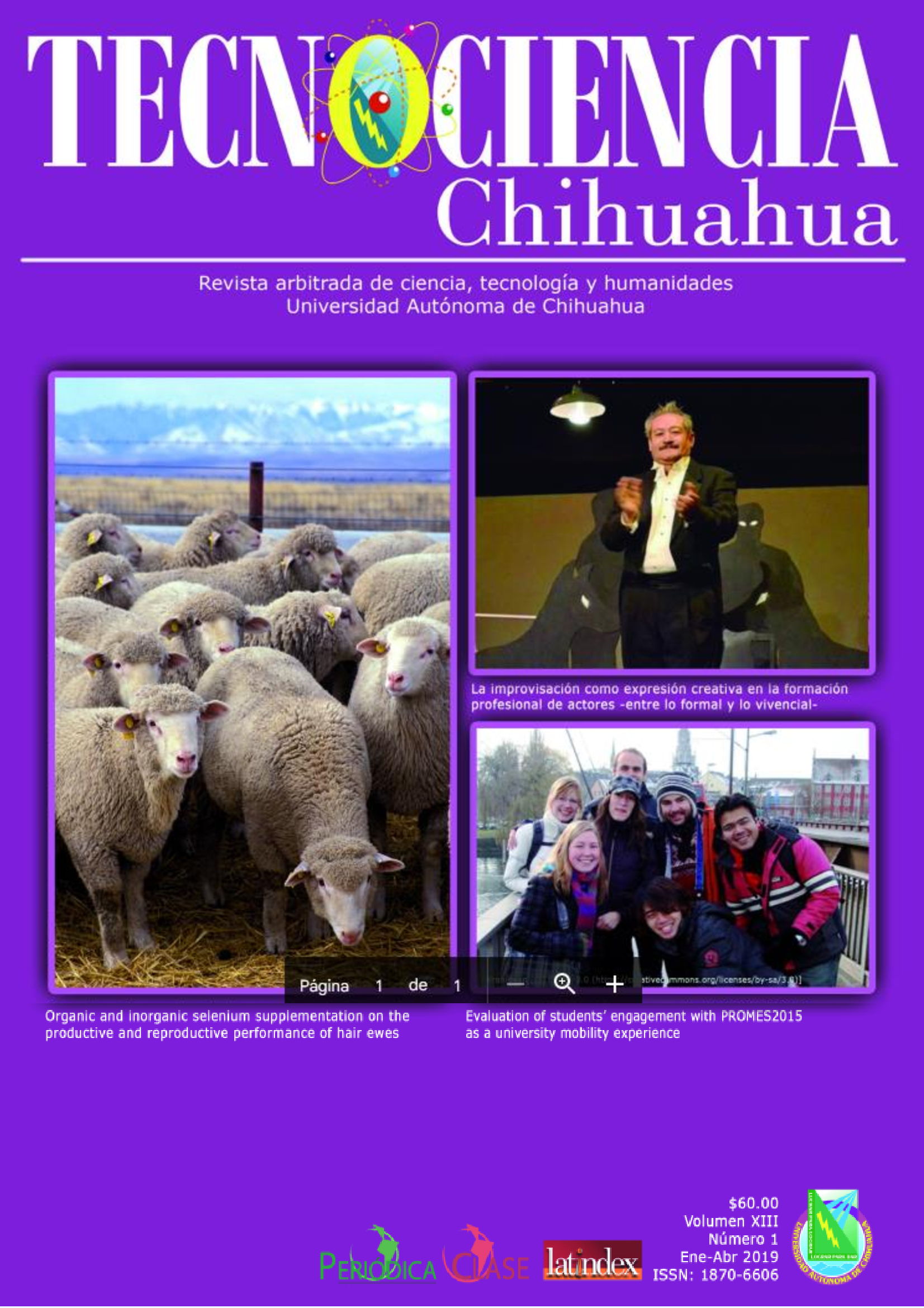Evaluation of students' engagement with PROMES2015 as a university mobility experience
Evaluación de la participación de estudiantes con PROMES2015 como experiencia universitaria de movilidad estudiantil
DOI:
https://doi.org/10.54167/tch.v13i1.305Palabras clave:
Mexico, student mobility, academic mobility, internationalization, higher educationResumen
Student mobility is among the most important internationalization initiatives for higher education institutions. This article describes the influence that student academic mobility has on the training of future professionals at the Autonomous University of Chihuahua (UACH, Mexico) and its students’ perceptions toward UACH’s Student Mobility Program (PROMES). Under such aim, the research objectives were to determine the opinion of participating students regarding the exchange process, the academic quality of the destination universities, the academic cooperation offices of the destination universities, and toward PROMES’ management. This research was quantitative, non- experimental, and transversal. The methodology used was a case study conducted only within UACH using simple random sampling, which was selected from the 170 undergraduate students that participated in PROMES during 2015 (confidence level of 90 %, margin of error of 7.5 %). The survey consisted in four main sections, which were intended for students to evaluate four factors related to PROMES: a) exchange process; b) academic quality of the destination university; c) support of the academic cooperation offices; and d) PROMES’ management at UACH. Results are presented according to four dimensions that the survey evaluated, which include: the exchange process, academic quality of the destination university, support of the academic cooperation offices, and PROMES’ management at UACH. These results point toward important statistical correlations regarding the relationship between how students value their academic development and the quality of the facilities in the destination universities, as well as with the quality of the educational programs.
Descargas
Citas
Bennion, A., & Locke, W. (2010). The early career paths and employment conditions of the academic profession in 17 countries. European Review, 18(S1), S7-S33. http://doi.org/10.1017/S1062798709990299
Bista, K., & Foster, C. (Eds.). (2016). Campus support services, programs, and policies for international students. Hershey, USA: IGI Global; 1st edition. ISBN13: 9781466697522|ISBN10: 1466697520|EISBN13: 9781466697539
Camino-Esturo, E. (2018). La movilidad de estudiantes en América Central: ¿En busca del hegemonic knowledge? América Latina Hoy, 77, 137-158. https://www.redalyc.org/articulo.oa?id=30854700007
Cantwell, B., Luca, S.G., & Lee, J. J. (2009). Exploring the orientations of international students in Mexico: differences by region of origin. Higher Education, 57(3), 335-354. https://doi.org/10.1007/s10734-008-9149-x
Cortez, C. (2016). Intercambios en la UACH llevaron a estudiantes a 38 países. http://tiempo.com.mx/noticia/53075-intercambios_en_la_uach_llevar.
Flores, D. (2015). La movilidad académica y estudiantil: un tema en la agenda de la investigación educativa en México. http://www.rimac.mx/la-movilidad-academica-y-estudiantil-un-tema-en-la-agenda-de-la-investigacion-educativa-en-mexico. Accessed 16 October 2018.
Gacel, J. (2019). La dimensión internacional de las universidades mexicanas. Revista Educación Superior y Sociedad (ESS), 11(1 y 2), 121-142. Recuperado a partir de https://www.iesalc.unesco.org/ess/index.php/ess3/article/view/135
González, J., & Gómez, C. (2012). Sugerencias para una política de la internacionalización de la educación superior en México en la segunda década del siglo XXI. Mundo Siglo XXI: Revista del CIECAS-IPN, 7(27), 25-34. https://www.mundosigloxxi.ipn.mx/pdf/v07/27/03.pdf
Jamaludin, N., Sam, D., & Sandal, G. (2017). Destination motivation, cultural orientation and adaptation: International students' destination-loyalty intention. Journal of International Students, 8(1), 38–65. https://doi.org/10.32674/jis.v8i1.151
Kim, T. (2017). Academic mobility, transnational identity capital, and stratification under conditions of academic capitalism. Higher Education, 73(6), 981–997. https://doi.org/10.1007/s10734-017-0118-0
Knight, J. (2005). Un modelo de internacionalización: Respuesta a nuevas realidades y retos. pp. 1-38. In H. de Wit, C. Jaramillo, & J. Knight (Eds.), Educación superior en América Latina: La dimensión internacional. Bogota, Colombia: Banco Mundial. ISBN 958-97647-8-9. https://bit.ly/3BW8S1C
Marúm Espinosa, E. (1997). Las implicaciones del TLC en la educación superior mexicana Perfiles Educativos, vol. XIX, núm. 77. https://www.redalyc.org/articulo.oa?id=13207710
Morley, L., Alexiadou, N., Garaz, S., González-Monteagudo, J., & Taba, M. (2018). Internationalisation and migrant academics: the hidden narratives of mobility. Higher Education 76(3), 537-554. https://link.springer.com/article/10.1007%2Fs10734-017-0224-z
Pherali, T. J. (2012). Academic Mobility, Language, and Cultural Capital: The Experience of Transnational Academics in British Higher Education Institutions. Journal of Studies in International Education 16(4): 313–333. https://doi.org/10.1177/1028315311421842
Rodríguez-Bulnes, M., Vences-Esparza, A., & Flores-Alanís, I. (2016). La internacionalización de la educación superior: Caso UANL. Opción, 32(13), 560-582. https://www.redalyc.org/articulo.oa?id=31048483028
Romo-González, J. & Tarango, J. (2016). Métodos estadísticos con SPSS aplicados a la educación. Buenos Aires Ed. Alfagrama. ISBN: 9789871305940
Sebastián, J. (2004). Cooperación e Internacionalización de las Universidades. Buenos Aires Ed. Biblos. ISBN: 978-950-786-446-9
Secretaría de Relaciones Exteriores. (2018). Mexican government scholarships for international students 2018. https://embamex.sre.gob.mx/finlandia/index.php/noticias/convocatorias-calls/79-becas-gobierno-mexico-2018. Accessed 16 October 2018.
Stronkhorst, R. (2005). Learning Outcomes of International Mobility at Two Dutch Institutions of Higher Education. Journal of Studies in International Education 9(4): 292–315. https://doi.org/10.1177/1028315305280938
Tiana Ferrer, A. (2012). La contribución de la movilidad académica a la construcción de un espacio Iberoamericano de educación superior. Revista Lusófona de Educação 21: 53-68. https://www.redalyc.org/articulo.oa?id=34924585004
United Nations Educational, Scientific and Cultural Organization (1998). World Conference on Higher Education: Higher education in the twenty-first century. Vision and action. Paris: France: UNESCO. http://unesdoc.unesco.org/images/0011/001163/116345e.pdf. Accessed 16 October 2018.
Universidad Autónoma de Chihuahua. (2018). Servicios internacionales. http://internacional.uach.mx. Accessed 16 October 2018.
University of Windsor. (2018). Scholarships for Mexican students. https://www.uwindsor.ca/studentawards/international-students-scholarships. Accessed 16 October 2018.
Varela, L. (2005). El referente de la internacionalización y sus inherencias para la educación superior pública. Revista Educación 29(2): 11-33. https://www.redalyc.org/articulo.oa?id=44029202
Voloschin, L. (2011). Interculturalidad e internacionalización en la Universidad Nacional de Cuyo: La movilidad internacional de estudiantes universitarios (Bachelor Thesis). Mendoza, Argentina: Universidad Nacional de Cuyo. http://bdigital.uncu.edu.ar/objetos_digitales/6081/tesis-fcpys-voloschin.pdf. Accessed 16 October 2018.
Wächter, B. (2003). An Introduction: Internationalisation at Home in Context. Journal of Studies in International Education 7(1): 5–11. https://doi.org/10.1177/1028315302250176
Publicado
Cómo citar
-
Resumen392
-
PDF52
-
HTML5

















